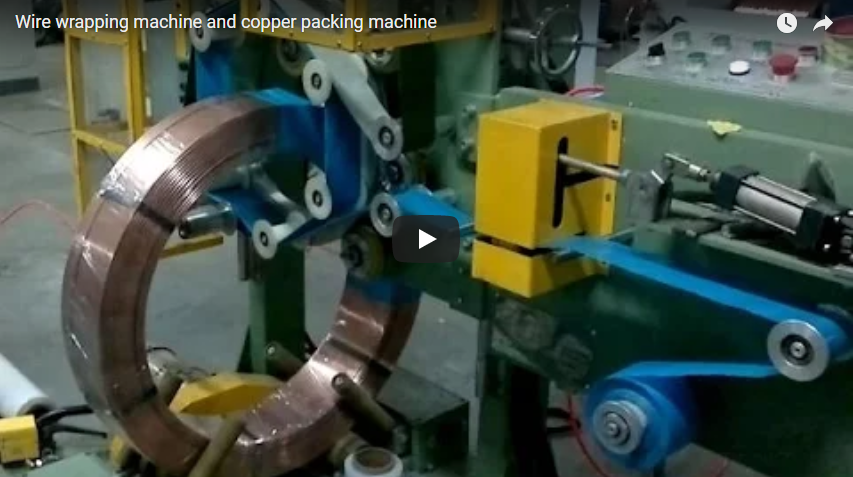Automatic Wire Wrapping Machines: Enhancing Protection for Steel and Copper Coils
Protecting steel wire, copper wire, and other coiled products during handling, storage, and transportation is crucial in many industrial sectors. Damage from moisture, dust, or physical impact can lead to significant material loss and operational delays. Automatic wire wrapping machines provide a robust and efficient solution for applying protective packaging materials to these valuable resources.
1. Understanding the Core Functionality
At its heart, an automatic wire wrapping machine utilizes an orbital wrapping process. Here’s a breakdown of the typical operational sequence:
- Loading: The wire coil (or spool) is placed onto the machine's infeed conveyor or directly onto support rollers within the wrapping station.
- Positioning: The coil is automatically centered or positioned optimally relative to the wrapping ring.
- Wrapping Cycle: A rotating ring or shuttle, carrying the chosen wrapping material (like stretch film or paper), revolves around the outer diameter of the stationary or slowly rotating coil.
- Material Application: As the ring orbits, it dispenses the wrapping material, overlapping each layer according to pre-set parameters to ensure complete coverage.
- Tension Control: Integrated tensioning systems maintain consistent pressure on the wrapping material, ensuring a tight, secure wrap without damaging the wire product.
- Cutting and Sealing: Once the programmed number of wraps is complete, an automatic mechanism cuts the material and typically seals the tail end to the coil.
- Unloading: The wrapped coil is then moved off the machine via an outfeed conveyor or manual removal.
2. Key Applications in Industry
These machines are indispensable in various environments dealing with wire and cable products:
- Steel Mills: Protecting coils of drawn steel wire, wire rod, and reinforcing bar (rebar) coils.
- Copper Wire Manufacturing: Securing spools and coils of copper wire used in electrical and telecommunications applications.
- Cable Production: Wrapping large drums or spools of power, control, and data cables.
- Wire Drawing Facilities: Packaging processed wire before shipment or further processing.
- Distribution Centers: Repackaging or reinforcing packaging for logistical purposes.
3. Common Types of Wire Wrapping Machines
While variations exist, machines generally fall into categories based on orientation and coil handling:
- Horizontal Axis Wrappers: The most common type for standard wire coils. The coil rests on support rollers, and the wrapping ring travels horizontally around its circumference.
- Vertical Axis Wrappers: Often used for larger spools or drums that are loaded upright. The wrapping ring moves vertically along the height of the spool while the spool may rotate.
4. Essential Wrapping Materials for Optimal Protection
The choice of wrapping material depends on the specific protection requirements:
- Stretch Film (LLDPE): Provides excellent containment, dust protection, and some moisture resistance. Its elasticity creates a tight wrap.
- Kraft Paper: Offers a breathable barrier against dust and minor scratches. Often used for interleaving or as a primary wrap where plastic is undesirable.
- VCI Paper/Film (Volatile Corrosion Inhibitor): Impregnated with chemicals that vaporize and form a protective molecular layer on the metal surface, preventing rust and corrosion. Crucial for long-term storage or shipping in humid environments.
- Woven Fabric / PP Woven Belt: Provides strong, tear-resistant protection against physical damage during rough handling.
5. Technical Specifications to Consider
When evaluating a wire wrapping machine, key parameters include:
- Coil/Spool Dimensions:
- Outer Diameter (OD): e.g., 500mm - 2000mm
- Inner Diameter (ID): e.g., 300mm - 1500mm
- Width/Height: e.g., 100mm - 1000mm
- Maximum Coil Weight: e.g., 50kg - 5000kg
- Wrapping Ring Speed: Measured in RPM (Revolutions Per Minute), affecting throughput.
- Wrapping Material Specifications: Compatible roll width, core diameter, and outer diameter.
- Overlap Adjustment: Typically variable from 10% to 90% via PLC control.
- Control System: PLC (Programmable Logic Controller) with HMI (Human-Machine Interface) touch screen for parameter setting, recipe storage, and diagnostics.
- Power Requirements: Voltage, phase, and frequency.
- Pneumatic Requirements: Air pressure (if applicable for clamping/cutting).
6. Operational Advantages & Efficiency Gains
Implementing an automatic wire wrapping machine yields significant benefits:
- Consistent Wrap Quality: Eliminates variations inherent in manual wrapping, ensuring uniform protection for every coil.
- Reduced Labor Costs: Automates a labor-intensive process, freeing up personnel for other tasks.
- Enhanced Product Protection: Minimizes damage from handling, moisture, dust, and corrosion, reducing scrap rates and customer complaints.
- Increased Throughput: Wraps coils much faster than manual methods, improving overall packaging line efficiency.
- Material Savings: Precise control over tension and overlap often optimizes material consumption compared to manual wrapping.
- Improved Operator Safety: Reduces manual handling and exposure to repetitive motions associated with hand wrapping.
7. Integrating into the Workflow: Considerations for Fabricators
Modern wire wrapping machines are designed for ease of integration and operation:
- User-Friendly Interfaces: Touch screen controls allow operators to easily select pre-programmed wrapping recipes, adjust parameters, and monitor the machine status.
- Automation Integration: Can be seamlessly integrated into automated production lines with conveyors, sensors, and central control systems.
- Safety Features: Equipped with safety fencing, light curtains, emergency stops, and enclosed moving parts to protect operators.
- Maintenance: Routine checks typically involve inspecting rollers, belts, tensioners, and the cutting mechanism. PLC diagnostics can aid in troubleshooting.
In conclusion, the automatic wire wrapping machine is a vital asset for any operation handling steel or copper wire coils. It provides a reliable, efficient, and cost-effective method for protecting valuable products, ensuring they reach their destination or next processing stage in optimal condition. By automating the wrapping process, businesses can significantly enhance productivity, reduce waste, and maintain high standards of product quality and presentation.
For specific coil packing machine solutions, you may find more information here:
https://www.fhopepack.com/Coil_packing_machine.html
info@fhopepack.com


